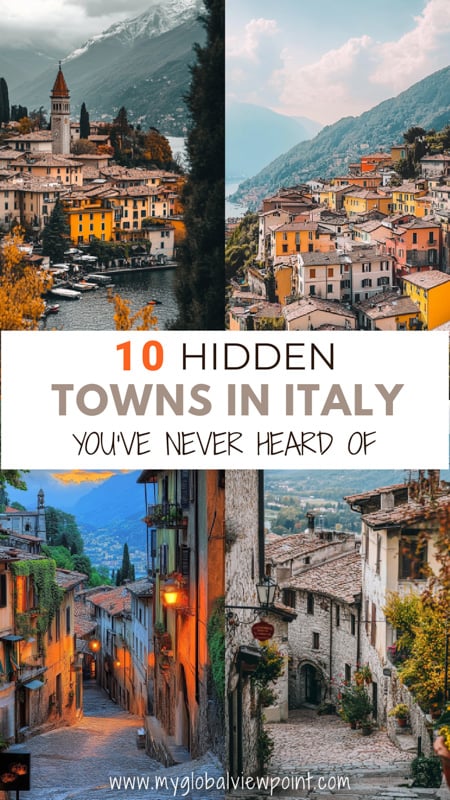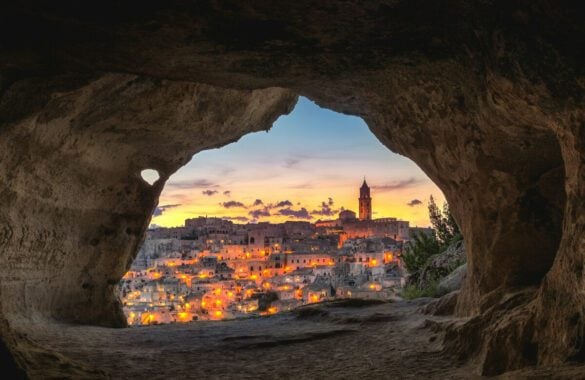Ready to explore Italy beyond the tourist hotspots? I’m here to share 10 of the most beautiful towns in Italy that are waiting to be explored.
Over the years, I’ve had the chance to wander through some lesser-known towns across the country, and I’ve got to say, they’re seriously stunning. This guide is all about the prettiest towns in Italy that you’ve never heard of.
You know the usual suspects like Rome and Venice, right? Well, let me introduce you to places like Bobbio and Ascoli Piceno. These towns are the real deal—unspoiled, charming, and just as beautiful as the big names. I’m excited to show you why these places made such an impression on me. Let’s dive into these gorgeous towns that have stayed with me long after my visits. Ready to discover some of my favorite hidden gems in Italy?
Overview of Italy’s most beautiful towns
Italy is stacked with famous spots, but there’s a whole other world beyond places like Rome and Venice. If you’re curious about where else to explore, here’s a quick guide on what each of these lesser-known gems is best for:
- Best for foodies: Alberobello
- Best for beach lovers: Tropea
- Best for art and culture: Orvieto
- Best for nature: Cividale del Friuli
Now, let’s kick off with Ascoli Piceno, where historic meets lively in the most enchanting way.

1. Ascoli Piceno
Ascoli Piceno is honestly one of Italy’s best-kept secrets, and I can’t figure out why more people don’t know about it. This gorgeous town in Marche sits about 200km from Rome, but it feels like a world away from the tourist madness. The main square, Piazza del Popolo, is seriously one of the most elegant I’ve ever seen in Italy – and that’s saying something.
I spent hours just sitting at Caffè Meletti (it’s been there since 1907!) watching locals do their evening stroll. The whole square is this perfect mix of medieval towers and Renaissance palaces, all built from local travertine stone that glows golden in the evening light. But here’s what you really can’t miss: the olive ascolane. These stuffed fried olives are basically Ascoli’s gift to the world, and honestly, they’re way better than they sound.
Getting there is pretty easy – there’s a train station with regular connections, and if you’re driving, parking isn’t the nightmare it is in bigger Italian cities. The Cattedrale di Sant’Emidio is worth a look, and if you’re feeling adventurous, take a short drive to Castel Trosino for some incredible mountain views. I’d pair this with Urbino (about 90 minutes away) if you’re doing a Marche road trip.

2. Matera
Let me be straight with you – Matera is going to blow your mind, but it’s also going to test your patience during peak season. These ancient cave dwellings, called the Sassi, are literally carved into limestone cliffs, and walking through them feels like time travel. It’s no wonder filmmakers love this place – the Bond movie “No Time to Die” was shot here.
The logistics are actually pretty manageable now. Bari Airport is about 45 minutes away by car, and there are buses that run regularly. But here’s the thing – if you’re staying in the Sassi (which you absolutely should), pack light. Those cobblestone paths and stairs are not suitcase-friendly. I learned this the hard way.
The guided tours start around €15 and they’re actually worth it because the history is incredible. You can visit a traditional cave house for about €8 that shows you how families actually lived here until the 1950s. The San Pietro Caveoso area has amazing restaurants built into caves – I had dinner at a place where the dining room was literally a former Byzantine church.
Best time to visit? Early morning or late afternoon. The stone catches the light beautifully at sunset, and honestly, it’s when Matera looks most magical. Pair this with Alberobello (about an hour away) for the perfect Puglia road trip.
- Read next: Breathtaking Places in Puglia

3. Alberobello
Alberobello is like stepping into a fairy tale, but let’s be real – it knows it’s cute and acts accordingly. These trulli houses with their cone-shaped roofs are absolutely unique, and the town has over 1,500 of them clustered together. UNESCO status means crowds, especially between 10am-4pm, but I’ve got a secret for you.
Hit the Rione Aia Piccola district early in the morning or stay overnight. Most day-trippers stick to Rione Monti (which has all the shops), but Aia Piccola is where actual people still live in trulli. You can peek into shops selling local products, but honestly, some of it’s pretty touristy.
The Trullo Sovrano museum (€2 entry) is the only two-story trullo in town and gives you a real sense of how these things work. But what I really loved was just wandering the narrow streets with a gelato. Parking costs about €6 for the whole day at the main lots, which isn’t bad considering the location.
If you’re driving, this pairs perfectly with Locorotondo (15 minutes away) and Ostuni (45 minutes). Stay at one of the trulli hotels if you can – sleeping in a cone-shaped room is definitely a bucket list experience, even if the acoustics are weird.
- Read next: Most Beautiful Places in Europe

4. Orvieto
Orvieto is basically Italy showing off. This town sits on top of a volcanic plateau like some medieval fortress, and the views across Umbria are absolutely incredible. The Duomo is the main event here – this massive Gothic cathedral with a facade that looks like it’s made of rainbow mosaics.
The cathedral ticket costs €8 and includes access to the San Brizio Chapel (with Signorelli’s famous frescoes), the museum, and even the underground areas. Trust me, it’s worth every euro. The art inside is mind-blowing, and the chapel alone could keep you busy for an hour.
But here’s what most people miss – Orvieto Classico wine. This isn’t just tourist marketing; it’s actually really good. I spent an afternoon at Palazzone winery (about 10 minutes outside town) and it was one of the best tastings I’ve had in Italy. The town itself is perfect for wandering – narrow medieval streets, tiny shops selling ceramics, and restaurants that actually cater to locals, not just tourists.
Getting there is super easy – there’s a train from Rome (about 1.5 hours), or it’s a quick drive if you’re exploring Umbria. The funicular from the train station up to the old town runs every 15 minutes and saves your legs. Pair this with Civita di Bagnoregio (the “dying city”) for an epic day trip.
- Read next: Most Beautiful Cities in Italy

5. Tropea
Tropea is what the Amalfi Coast wishes it could be – dramatic cliffs, turquoise water, and actual beaches you can enjoy. This Calabrian gem sits on the Costa degli Dei (Coast of the Gods), and honestly, the name isn’t an exaggeration. The beach below town is this perfect curve of white sand, and the water is so blue it looks fake.
The logistics are pretty straightforward – Lamezia Terme Airport is about an hour away, or you can take the train (though the station’s a bit of a walk from the center). The old town is tiny and built on cliffs, so expect some serious stairs. But those stairs lead to restaurants with incredible sea views.
You’ve got to try the red onions – I know it sounds weird, but Tropea onions are famous throughout Italy for being super sweet. They even make onion gelato, which is… an experience. For dinner, get away from Corso Vittorio Emanuele and find the smaller streets – that’s where locals eat.
The Sanctuary of Santa Maria dell’Isola sits on a rock formation in the bay and makes for incredible photos, especially at sunset. If you’re feeling adventurous, take a boat trip to Capo Vaticano (25 minutes by car) – it’s supposed to have some of the best beaches in the world. I stayed three nights and it wasn’t enough. Pair this with Pizzo for their famous tartufo ice cream.

6. Cividale del Friuli
Cividale del Friuli is tucked away in northeast Italy near the Slovenian border, and it’s got this fascinating mix of Italian and Slavic culture that you won’t find anywhere else. The Devil’s Bridge is the star attraction – this dramatic stone arch spans a rocky gorge and looks like something from a fantasy movie.
The Lombard Temple is supposedly one of the most important examples of early medieval architecture in Italy, and honestly, the frescoes inside are stunning. But what really struck me was how the town feels lived-in rather than museum-like. You’ll hear different languages on the streets, and the food has influences from both sides of the border.
The Udine Airport is about 45 minutes away, or you can easily drive here from Venice (about 1.5 hours). If you’re doing the Friuli wine country, this is the perfect base – the Collio wine region is right nearby, and the white wines here are seriously underrated.
I spent a morning just wandering the medieval streets and discovered this tiny restaurant where the owner spoke four languages and served the best frico (cheese and potato pancake) I’ve ever had. It’s the kind of place where you feel like you’ve discovered something special. Pair this with Aquileia and its amazing Roman ruins, or venture into Slovenia for a day – the border is literally minutes away.

7. Sulmona
Sulmona in Abruzzo is famous for two things: being the birthplace of the Roman poet Ovid, and making the best confetti (sugared almonds) in Italy. But honestly, I went for the mountains – this town sits in a valley surrounded by the Apennines, and the views are absolutely spectacular.
Piazza Garibaldi hosts a market twice a week, and it’s the real deal – locals buying vegetables and chatting, not tourist souvenirs. The medieval and Renaissance buildings around the square are gorgeous, and unlike other Italian hill towns, everything’s pretty much at street level, so it’s easy to explore.
The L’Aquila Airport is about an hour away, but honestly, this is road trip territory. You’re in the heart of Abruzzo National Park, so if you’re into hiking or just want to see a side of Italy that most tourists miss, this is perfect. The Gran Sasso mountains are right there, and in winter, you can actually ski.
I found this family-run confetti shop where they’ve been making the same recipes for generations – they do factory tours and tastings, and it’s way more interesting than it sounds. The town is quiet (almost too quiet in the off-season), but that’s exactly what makes it special. Pair this with L’Aquila if you want to see earthquake reconstruction efforts, or head to the coast – Pescara is about 90 minutes away.
- Read next: Hidden Gems in Italy Only Locals Know

8. Savoca
Savoca is tiny, perched in the hills of Sicily, and famous for one thing – The Godfather. Bar Vitelli still looks exactly like it did in the movie, and yes, you can have a coffee there and feel like you’re in a film scene. But honestly, the town is worth visiting even if you’ve never seen the movies.
The views across the Sicilian countryside toward the sea are incredible, and the narrow, winding streets have this timeless quality. Unlike a lot of Sicilian tourist spots, Savoca is still pretty quiet – you can actually hear birds singing and church bells, not tour groups.
It’s about 35km from Messina and 25km from Taormina, so it’s perfect for a half-day trip. The drive up is scenic but twisty, so take your time. I spent about two hours here, had lunch at a tiny trattoria where the owner’s grandmother was making pasta in the back, and felt like I’d discovered something special.
The Chiesa Madre has some interesting art, and there’s a mummy crypt if you’re into that sort of thing. But really, this is about atmosphere – sitting in that famous bar, looking out over the valley, and imagining what life was like when time moved slower. Pair this with Castelmola or make it part of a Taormina day trip.
- Read next: Best Places to Live in Italy

9. Bobbio
Bobbio in the Trebbia Valley is one of those places that makes you want to slow down. The Ponte Gobbo (Devil’s Bridge) is this wonderfully wonky medieval bridge with uneven arches that stretches across the crystal-clear Trebbia River. It’s not perfectly Instagram-symmetrical, and that’s exactly what makes it beautiful.
The abbey dates back to the 600s and has this peaceful, timeless quality. The town itself feels like a living museum – narrow stone streets, ancient buildings, and locals who actually seem happy to see visitors. I spent an afternoon just sitting by the river with a book and a bottle of local wine.
It’s about 70km from Piacenza and 110km from Milan, so it’s doable as a day trip if you’re in northern Italy. But honestly, I’d recommend staying overnight – there are some beautiful agriturismos in the valley, and the town has a completely different vibe after the day-trippers leave.
The Trebbia River is supposedly one of the clearest in Italy, and in summer, you can actually swim in it. The hiking trails along the valley are gorgeous, and if you’re into slow travel, this is perfect. The food is simple but incredible – lots of mushrooms, local cheeses, and wines you’ve never heard of but will remember forever. Pair this with Parma (about an hour away) for a perfect Emilia-Romagna experience.

10. Pitigliano
Pitigliano in southern Tuscany is like something from a fantasy novel – the entire town is built into a cliff of volcanic stone, and it literally looks like it’s growing out of the rock. The Jewish heritage here is unique in Italy – there’s an old synagogue and a fascinating history of the community that lived here for centuries.
The underground tunnels and caves beneath the town are incredible – some were used as storage, others as hiding places. You can explore them on guided tours, and it’s definitely worth doing. The views from the cliff edge, especially at sunset, are absolutely breathtaking.
It’s about 50 minutes from Grosseto and under two hours from Rome, so it’s perfect for a day trip or as part of a southern Tuscany tour. Saturnia hot springs are nearby if you want to combine sightseeing with relaxation.
I stayed overnight and had the town basically to myself after 6pm – wandering the medieval streets, having dinner at a restaurant carved into the cliff, watching the sunset paint the valley below. The wine here is excellent (you’re still in Tuscany, after all), and the restaurants serve hearty Maremma cuisine that’s totally different from what you’ll find in Florence. Pair this with Sorano and Sovana for a perfect “tufa towns” triangle tour.
- Read Next: 19 Most Beautiful Places in Italy to Visit






